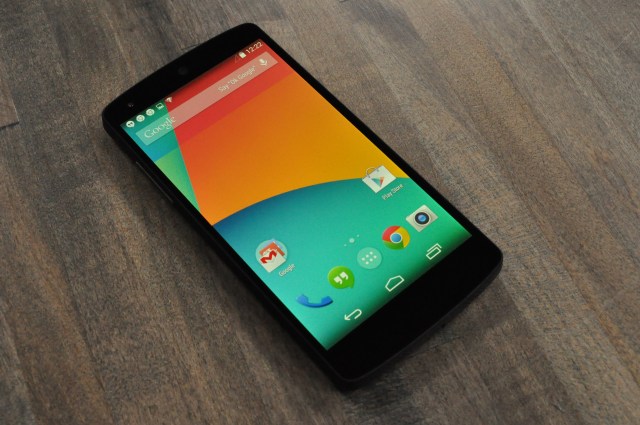The Nexus 5 is here! The Nexus 5 is here!
After months of hype and more questionably “accidental” leaks than any device in recent memory, Google announced their new flagship Android handset this morning.
I’ve only had the device in my hands for a few hours, so it’ll be a few days before I’m ready to give my final yay or nay on this thing. With that said, I recognize that I’m amongst a very lucky few to have access to this thing before they start leaving the warehouse en masse later this week, so I figured I’d share some early impressions.
Thoughts so far:
- It’s quite nice looking, though not in a particularly unique way. Look at it from more than a few feet away, and most folks probably wouldn’t have any idea what phone they were looking at. It’s a big glass screen with a matte black back; I’m… not sure how you could get any more standard.
- The soft touch backside gets fingerprint-tastic, and fast. I had to wipe it almost constantly for our hands on photos. For reference, I’m using the black device and don’t have particularly oily hands.
- As you’d expect of a device with a nearly 5-inch (4.95 inches, to be specific) screen, it’s big. Real big. Any bigger, in fact, and I’d say it’s too big. And yet, Google and LG managed to keep it justwithin the realm of sanity. It’s not a strictly two-hand device, but unless you’ve got hulk hands, expect to need a second hand more often than not.
- With Android 4.4, Google Search is now automatically integrated into every single page of your homescreen launcher, and can be triggered by voice through an “Okay, Google” hot keyword. Search is always just there. It’s quite nice.
- Google Now is now always the left-most screen on your homescreen, which is a smart move on Google’s part. Google Now is incredibly neat (if slightly terrifying) — but, previously stuffed behind a swipe from the very bottom of the screen, it was far too easy to forget it was there. You can still reach it with a swipe up from the bottom, need be.
- It’s smooth. Really smooth. Every transition, every fade in – it’s like butter. If it stays this smooth after a few weeks of use, it’s by far the smoothest Android experience I’ve had; alas, that rarely seems to be the case with Android.
- The camera seems above average, but not mind blowing. I’ll save the example shots until I’ve had a chance to pit it head-to-head with a few comparable devices. The camera is also a bit crashy, though that might be my specific unit; three times now, the camera has just stayed at a black screen when I tried to open it
- Android 4.4 overhauls the dialer, with the main feature being a knowledge of nearby businesses. Just type a business name into the same field where you’d normally type the first few letters of your friends name, and it pulls up the details for nearby locations. In my early tests, this feature works very well. Typing “Starbucks” pulled up 8+ locations near me (hey, it’s San Francisco), broken down by their location, each offering their phone number at a click. It works in reverse, too; I had one of those Starbucks locations call me, and the phone identified the caller as such. Google says all this data is piped in from Google Maps
- In Google’s HDR+ mode (which takes photos in rapid succession and combines the best parts of each into one photo), the camera can be slow. Twice I moved the camera before it was done (but after the shutter sound went off), ending up with a photo of the ground.
- While Android 4.4 is largely focused on optimizations that allows it to run on lower-end devices, there are a number of lil’ subtle changes that really spruce up the place. The top bar and bottom nav bar are both translucent now, allowing the homescreen background to go fullbleed across the screen . The widgets drawer has been moved out from the pop-up app drawer (which always seemed like a weird location), and back to being behind a long press on the home screen (like it was in Android of yesteryear).

The Nexus 5 comes in two colors: one black, and one white. $349 gets you a 16GB model, while $399 gets you 32GB. Both of those devices are unlocked and off-contract, mind you — for the price, the hardware stuffed into this phone is rather amazing.
Alas, it might be tough to get one for a while. The Nexus 5 just went on sale this morning, and almost immediately sold out. If you’re one of the people who got their order in: don’t worry, so far I’d say you’ve made a solid choice.
While my notes above may seem neutral (or even neutral-negative), I’m actually pretty darn pleased with the device so far. It feels like they took the Nexus 4, the Moto X, and the HTC One — all three devices of which were devices I really liked — and mashed them together, pulling in many of the best parts of each. If you’re already an Android fan or a Nexus 4 owner, you’ll like what you see here. If you’re an iPhone user, this one really could be the one to convince you to make the switch. I know I’m tempted.










